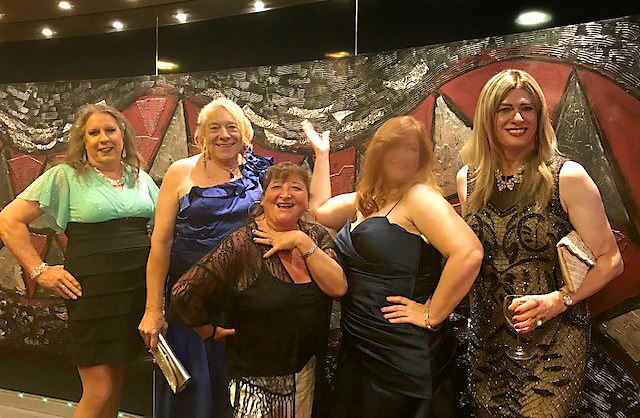| Society For the second selfsupport • Serenity • ServiceA 501(c)(3) non-profit organization. |
What is Crossdressing?
Crossdressers having fun on a cruise. What crossdressers are not While the vast majority of crossdressers are ordinary heterosexual men with an additional feminine dimension, we are stereotyped by society based on a highly visible minority who crossdress for entirely different reasons. We are not drag queens or female impersonators. Drag queens are usually gay or bisexual males who don women’s clothing either to mock gender stereotypes or to attract partners. Female impersonators dress to entertain. We are also not transgender, and we do not seek sexual reassignment. We are comfortable with our birth gender. Understanding the "Woman Within" There is within each man a set of personality potentials that are part of his birthright, but that society labels as “feminine” and demands that he suppress. Crossdressers have made contact with these potentials and found it fulfilling to express them. By integrating these into their personalities, crossdressers are able to smooth off some of the overtly masculine rough edges programmed by their upbringing. The result is a happier, healthier whole person. But why do they crossdress? Much speculation has centered on why some people crossdress. No one knows for sure. While some cite hormonal or genetic factors, others favor environmental factors. It appears that for many the clothing serves as a “lens” to facilitate focusing upon and developing personality elements society has assigned to the opposite gender. Is crossdressing a sexual phenomenon? Human beings are sexual creatures. Early on, many crossdressers find the activity sexually stimulating. However, research shows the sexual factor tends to become less prominent over time. Crossdressing is more a matter of personality than sexuality. For many, crossdressing is a form of essential personal expression—just as musicians need to play music, writers need to write, or ballplayers need to play ball. For crossdressers, a life without crossgender expression is as tragically deprived as the life of a musician forced to live without music. Like musical talent, crossgender expression can be seen as a gift. What types of people crossdress? Crossdressers come from all walks of life, races, creeds, and economic backgrounds. The phenomenon dates back many thousands of years. In some cultures, especially some American Indian tribes, crossdressers were highly respected as shamans. Most crossdressers are well-educated and come from conventional family backgrounds. The vast majority are heterosexual and most are, or have been, married. Most are happy in their masculinity, and only a small percentage opt to live as women full time. A few women are crossdressers, but they are much less numerous than their male counterparts. Perhaps this is due to the relative latitude society grants to women in matters of dress and self-expression. Can crossdressing be "cured"? The chief adjustment problem crossdressers face is overcoming societal attitudes. While these have been changing since crossdressers appeared on The Phil Donahue Show in 1987, acceptance is far from complete. Because of possible repercussions to their families, jobs, and friendships, many crossdressers lead a double life shrouded in secrecy. Some crossdressers decide to deny their feminine side and dispose of their clothing, only to return to crossdressing later, frustrated by the suppression of so significant a part of their personality. Some seek therapy, but as many therapists are not knowledgeable about crossgender issues, crossdressers sometimes find themselves educating the therapist rather than getting the help they seek. Nor are psychiatric drugs of any benefit. There is no “cure” for crossdressing, and most crossdressers do not want one! The crossdresser and his wife How a crossdresser’s wife accepts him depends on their own degree of insight and personal maturity, the strength of their relationship, and the way in which she learns about the crossdressing. Discovering his secret can send her on an emotional roller coaster ride of anger, fear, denial and grief. She may feel it threatens her own femininity and the future of their relationship. Open and honest communication is vital here. Once a wife or partner realizes her mate isn’t leaving her for another man or for a new life as a woman, or taking risks that could destroy their financial and family life, the two of them can seek a balanced solution that suits their own unique needs and circumstances. Healing comes when the wife or partner realizes that her mate is the same person she has always known, recognizes the risk her man has taken in revealing his innermost feelings, and appreciates the trust this represents. Many of the traits that attracted her in the first place—sensitivity, kindness, appreciation of beauty, etc.—can now be seen as belonging to that “woman within.” The crossdresser and his children
A crossdresser’s children don’t appear to be at any greater risk of becoming crossdressers themselves. Indeed, children benefit from exposure to a father who is usually more sensitive, creative, and involved in their lives than the average. The decision to tell the children about one’s cross-gender expression is a highly personal one, to be arrived at jointly by the parents, with the needs of the child paramount.
Crossdressers are usually torn between the desire to “protect” their children on the one hand, and the negative effects of deceit on the other. Telling the children at a time and under circumstances controlled by the parents, however, does forestall the children finding out somehow at a time when they are least prepared to deal with it.
In our experience, timing—when the children are told—is more important than what they’re told. Adolescence, a time of struggle to establish social and sexual identity, is not the right time (especially if the children are boys). If boys are not told earlier in childhood, it is generally best to wait until adulthood. On the other hand, children who are told in early childhood tend to accept cross-gender expression as “no big deal.” Such children are well prepared to deal with the diversity of modern society. Looking for support? Support should be based on the following principles: 1) that every human being has the right to full expression of all personality potentials, both masculine and feminine; 2) that individuals should strive to balance and integrate both their masculine and their feminine aspects to produce a happier, more fulfilled whole person; 3) that needs of spouses and families are neither more nor less important than those of crossdressers; 4) that cross-gender expression should not remain a matter of shame and secrecy, but be integrated into everyday life. |
Donation goal
2%
|


